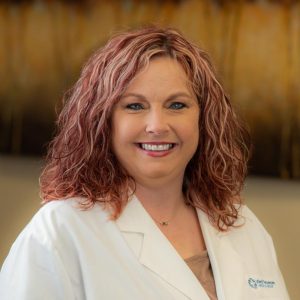March is Endometriosis Awareness Month. How much do you know about this common condition?
For many American women, endometriosis is a part of life. The condition, which often causes debilitating pain, affects nearly 11 percent of American females between ages 15 and 44—or around 6.5 million women and girls.

But what exactly is the condition, and how can you know if it’s causing your symptoms? Beckie Johnson, certified nurse midwife with West Tennessee Medical Group, offers some perspective in today’s blog.
Defining Endometriosis
Endometriosis is a women’s health condition where tissue that normally grows inside the uterus grows in parts of the body outside the uterus.
When uterine tissue—also called the endometrium—grows in the uterus, it thickens and then breaks down as part of the menstrual cycle. But when this tissue grows outside the uterus, there’s no way for it to exit the body, which causes a number of serious health issues.
While endometrium can grow in any part of the body, it most commonly appears on the ovaries, fallopian tubes and other parts of the pelvis, such as the tissues holding the uterus in place.
During a woman’s period, when the lining would typically shed from the uterus, it may also swell and bleed in the other places it grows. This can cause intense pain and other symptoms.
The Symptoms of Endometriosis
Because endometriosis symptoms are triggered by a woman’s menstrual cycle, they are often disregarded as “normal” PMS symptoms, at least at first. But symptoms related to endometriosis are often much more significant than premenstrual syndrome and can be debilitating.
Symptoms include:
- Abdominal, back or pelvic pain
- Bleeding between periods
- Constipation
- Diarrhea
- Excessive fatigue
- Heavy periods
- Menstrual cramps
- Nausea and vomiting
- Ovarian cysts
- Pain during intercourse or while using the restroom
Beyond these symptoms, endometriosis can cause scarring or damage to the fallopian tubes or pelvic wall, which can lead to infertility. The American College of Obstetricians and Gynecologists reports that around 40 percent of women who experience infertility have endometriosis.
Scar tissue can also cause tissue and organs to stick together, a type of growth called an “adhesion,” which leads to intense pelvic pain.
Who’s at Risk of Endometriosis?
Anyone who has a period is at risk of developing endometriosis. It commonly affects girls and women between the ages of 15 and 44, but it is most common among those in their 30s and 40s.
Certain factors can increase a person’s risk of endometriosis. These risk factors include:
- Having a mother, sister or daughter with the condition
- Having heavy periods that last more than seven days
- Having monthly menstrual cycles of less than 27 days
- Starting your period before age 11
On the other hand, certain factors can put you at a decreased risk. These factors include:
- Having a low amount of body fat
- Having been pregnant
- Regularly exercising for more than four hours per week
- Starting your period late in adolescence
If you’re experiencing the symptoms described above and have any risk factors for endometriosis, talk with your medical provider about what’s happening. He or she can talk you through your symptoms and determine next steps.
How Endometriosis Is Diagnosed & Treated
Your medical provider will first perform a thorough physical exam, including a pelvic exam. Some endometrial growths or cysts may be large enough to be felt during this exam.
He or she may also perform an ultrasound, either abdominally or vaginally, or request an MRI to view part of the inside of your body.
The only definitive way to diagnose endometriosis, though, is through a laparoscopic procedure. During this procedure, a medical provider will look for patches of endometriosis and may remove part of the tissue to biopsy.
If you’re diagnosed with endometriosis, your treatment will depend on several factors.
For girls and women who aren’t actively trying to become pregnant, oral contraceptives or an intrauterine device are often the first treatment prescribed. These hormonal birth control methods can help lessen pelvic pain and other symptoms that occur during your period.
For those who are hoping to conceive, medical providers may prescribe a type of medication that temporarily stops the menstrual cycle. This slows the growth of endometriosis and alleviates symptoms. After a period of time, the medication is stopped and the menstrual cycle resumes.
When endometriosis results in life-altering pain, surgery may be recommended. During a surgical procedure, patches of endometrium are removed. In the most severe cases, hysterectomy may be needed.
Believe your symptoms may be related to endometriosis? Talk with your medical provider about what you’re experiencing. Make an Appointment
